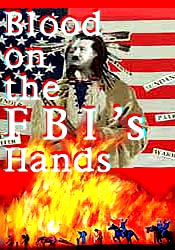Leonard Pelteir’s lawyer speaks in the Bay Area about the Native American movement, terrorism and civil rights
 |
|
by Christina Heatherton/PNN Media intern My pencil tears across the page in a frenzied scrawl, desperately trying to follow Bruce Ellison’s lecture about Leonard Peltier and the American Indian Movement. I catch a few alarming phrases "…1/3 of Native American women unwittingly sterilized…64 people on the reservation killed…blood on the FBI’s hands…" but the context and stories are completely unfamiliar to me. Dates, events, and names merge into irrelevance. I have never heard of the American Indian Movement and am as vaguely familiar with the name Leonard Peltier as any UC Berkeley-part-time-student-activist might be. After a few minutes I squint at my notes in the dim auditorium and solemnly realize that my pencil has been outpaced by my swifter confusion. I resign myself to observing the event from my seat, high at the back of the New College Auditorium in San Francisco. Ellison faces the audience of 35-40, sitting comfortably under warm lights with his arms casually folded on a table before him. His low-key manner and "aw-shucks" humility belie a well-educated confidence and sophistication. Bruce Ellison has served on Leonard Peltier’s defense team since Peltier’s original trial some 27 years ago. He flashes a self effacing smile and relates that at the time he was only a young lawyer who was often got to hold the other lawyers suitcases. For most of the evening, Ellison does not speak of Peltier. With a lawyer’s persuasive simplicity, he sweeps through the history of US-Native American relations to demonstrate that persecution of the Native Americans has historically coincided with growing speculation into Native American territory. The history of indigenous people in our country and throughout the world, he says, is a history of people being deemed "in the way" of land and of resource exploitation. Ellison launches into a litany of injustices beginning in 1874 when Native Americans were forcibly removed from reservations after gold was discovered on their land. He picks up a century later in the 1960’s and 70s, when 27 multinational corporations quietly began to stake claims of reservation land for gold, coal, uranium, iron, and natural gas extraction. It was during this time that the American Indian Movement (AIM) a leading proponent of indigenous rights emerged. In 1972, AIM lead a march on Washington called the "Trail of Broken Treaties" to protest the government’s defiance of past treaties as well as its responsibility for the impoverished conditions and suffering on Native American reservations. The march culminated in a raid on the Bureau of Indian Affairs. There AIM members uncovered classified documents which entailed the government’s plans to slowly eradicate the native people. Bruce Ellison’s tone becomes hardened as he relates that AIM discovered evidence that 1/3 of the female indigenous population between the ages of 18 and 25 had been involuntarily sterilized. Leonard Peltier was a member of AIM. In 1973 he participated in AIM’s occupation of Wounded Knee, a dramatic protest against the human rights violations occurring on the Pine Ridge Reservation. A corrupt, US backed, tribal government had been in control of the Pine Ridge Reservation and had been enforcing its laws through the deployment of a violent militia known as the GOON squad (Guardians of the Oglala Nation). The US government responded to AIM’s occupation with military force. A 71-day standoff between AIM and heavily armed federal authorities ensued. The FBI armed and equipped the GOON squad to smother AIM’s dissent. After the standoff, violence on the reservation increased under the GOONs’ reign of terror. Residents of the reservation and AIM members lived under the constant threat of violence. Mothers, children, husbands, and relatives became victims of random beatings, tortures, gang rapes, and murders. 64 men, women, and children were murdered during this time. No one ever stood trial for the crimes despite the FBI’s presence. It was in midst of this "climate of fear", as Ellison describes it, that two FBI agents were killed. On June 26, 1975, the two agents, driving an unmarked car, chased a small pick-up truck on to the ranch where AIM had its headquarters. A firefight broke out. AIM members heard the gunshots and believed they were under attack from the GOON squad. To protect the women, elders, and children inside, AIM members returned gunfire. In the skirmish, the two FBI agents and one Native American youth were killed. Four AIM members were accused of the agents’ murders including Leonard Peltier. After hearing details of the "climate of fear", as well as significant proof of FBI misconduct, and a lack of evidence condemning the AIM members, a conservative Midwestern jury acquitted the first two suspects. To suppress this embarrassing acquittal, according to Ellison, the FBI dropped the charges against the third suspect and targeted Leonard Peltier. Reading from an internal FBI document Ellison demonstrates that the government planned "to develop information to lock Peltier into the case" and place "the full prosecutive weight of the federal government" against him. Documents released from the Freedom of Information Act reveal that the government withheld and fabricated evidence, threatened and coerced witnesses, and flat out lied in order to get a conviction. In addition, Peltier’s lawyers were not allowed to introduce evidence of the "climate of fear" that had influenced the jury in the other trial. Peltier was convicted for the murder of the two FBI agents. He is currently in prison having served 26 years of his double life sentence. So here’s the punch line….. Terrorism, according to the government’s own federal guidelines, is defined as: "…the unlawful use of force and violence against persons or property to intimidate or coerce a government, the civilian population, or any segment thereof, in furtherance of political or social objectives." (28 Code of Federal Regulations Section 0.85) Ellison demonstrates that the federal government is guilty by its own definition. Its support of GOON squad violence and its neglect of Pine Ridge residents constituted an unlawful use of force against American citizens. Additionally, the government’s fraudulent prosecution of Leonard Peltier revealed its subversive capacity to manipulate the criminal justice system for political purposes. Ellison asks the audience to consider who the real terrorists are. Aside from its political agenda, Ellison suggests that persecution of Native Americans in the 70’s was additionally driven by economic objectives. He reveals that the FBI’s war on the American Indian Movement coincided with corporate plans to develop reservation land into the largest coal generating system in the country. Ellison points out that AIM attracted the most FBI attention when, in 1975, it adopted a decidedly more anti-corporate position with an emphasis on protecting land and water supplies from the corporate exploitation of mineral sources. With this shift, the FBI declared AIM one of most dangerous groups in the country. Of the many "remarkable" and "frightening similarities" Ellison draws between the government’s suppression of AIM 27 years ago and its current War on Terrorism, his reference to the recent ruling in the Oakland EarthFirst! trial resonates strongly with the government’s persecution of AIM. Last June’s trial revealed that the Oakland Police Department had conspired with the FBI to suppress EarthFirst!’s environmental activism. While the group had been accused of terrorist activity, it became apparent that the only interests that EarthFirst! had threatened were those of the timber industry in Northern California. The EarthFirst! example illustrates the questionable ground upon which the national climate of fear is being founded. Ellison’s voice gains a severe edge as he argues for the present relevance of Leonard Peltier’s case. He sees the same excessive governmental authority being granted to the FBI "not only without question but clearly without any consideration as to whether this new authority will actually in any way make us safer". The danger, he believes, is in the secrecy surrounding current government action. He sees secret military tribunals, for example, as being necessary to hide evidence of FBI misconduct and government abuse of the criminal justice system. Within the present climate of fear created by the government, Ellison suggests that dissension is being suppressed and civil liberties are being quietly decimated. As Ellison discusses the intensifying counter-surveillance operations occurring nationally, he proposes that the very people we are sitting next to might be gathering information about us. For a long self-conscious moment, the auditorium is gripped with uncertainty. I look warily at the circulating petition requesting my name and address. I scan the room for infiltrators. I spot a head of blonde dreadlocks, some billows of white floating above creased collars, long manes of black strung with feathers and beads, a stray perm, some deliberately unkempt, clean chic, and/or spiky heads, and a cluster of disheveled masses strangled back into pony tails. I see no suspects in the audience, but then again, I have no idea what the back of a fed’s head might look like.
|



